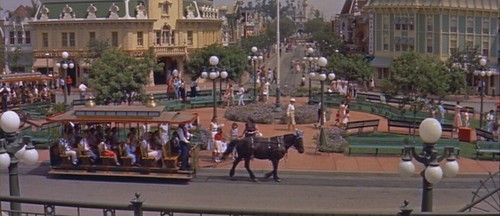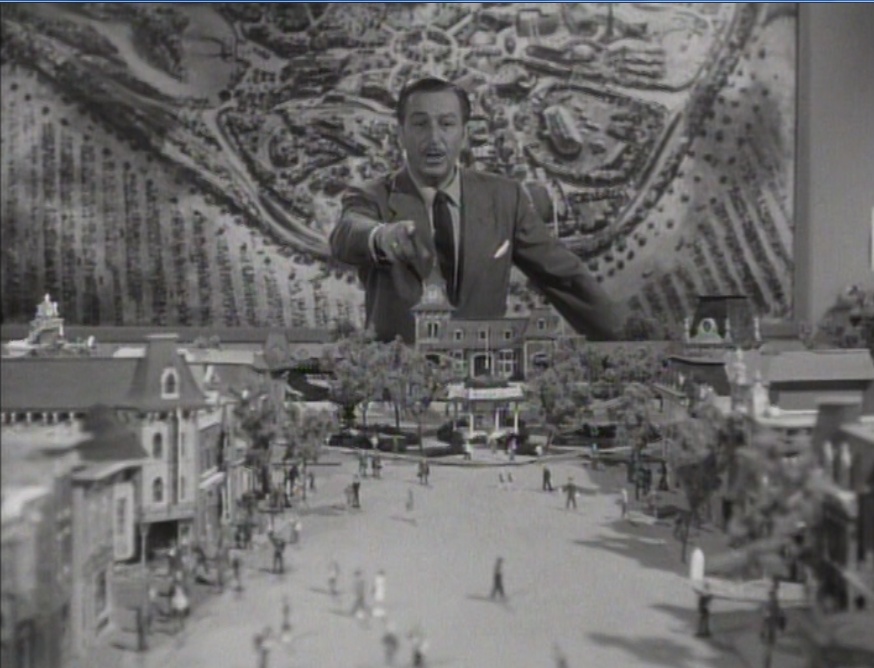I wrote the other day about Courthouse Square, the ubiquitous town centre used in countless films and TV shows. For someone like me, interested in both films and cities, a place like this is fascinating as a built embodiment of the kind of community that films and television shows hold up as an ideal. In reality, most of us live in far more mundane suburban environments that suffer various shortcomings: they are too dispersed, with residential, retail, and employment activities frequently located far apart; they have too little public transport, making us too dependent on cars; they are short of true public space, substituting instead private spaces such as shopping malls; and so on. Yet in films and television shows places like Courthouse Square are held forth as an alluring image of the town that has a discernible centre, public space, civic facilities, and an old-fashioned charm. These sets are interesting to an urban planner such as myself because they represent the best efforts of highly experienced dream manufacturers to build the ideal community.
What’s even more interesting, though, is the example of Disneyland. Essentially, what we have here is a filmmaker, Walt Disney, who after World War II became increasingly disinterested in making films and turned instead to place making. He purchased land on the fringe of the city that epitomises the post-war urban fabric, built an environment strikingly similar to one of these movie towns, and then charged admission to it. The front section of Disneyland, and the one section that every visitor must pass through, is Main Street USA, a tangible realisation of the Hollywood movie town (my essay here gives extensive detail on the traits of the classic Hollywood town). Disney, renowned for his escapist film fantasies, was here selling people an escape to the fantasy of a pleasant, pedestrian-friendly urban environment with a civic square and public transport. In postwar L.A. this was a commodity in such short supply that Disney was able to turn around the fortunes of his struggling business driven almost solely by his Disneyland profits.
If you think I’m overcooking this idea that Disneyland was an attempt to market people the experience of a particular kind of urban experience, consider how Walt Disney himself sold the idea of the park in the first episode of his “Disneyland” TV show, aired on 27 October 1954 (about nine months before the opening of the park):
(If at doesn’t start at the right spot the bit I’m referring to is at 4:50)
Main Street USA’s recreation of an old-fashioned town centre was obviously at the core of Disney’s nostalgia for a better urbanism (and note, incidentally, how easily Disney slips into calling a model of just Main Street USA a model of Disneyland itself). But there’s a lot about the rest of Disneyland that can be seen as an attempt to compensate for the failures of the surrounding city. Main Street USA is just one of the park’s pedestrian spaces: there’s also the park at the centre hub; the waterfront plaza that faces the water near the entry to Frontierland; and New Orleans Square (opened in 1966 and in planning during the final years of Disney’s life). When the park opened there was also a second main street, the miniaturised old west town of Rainbow Ridge (today this survives as part of the Big Thunder railway).

And seeing early footage of Disneyland, before every last inch of it was built out and the crowds took over, it is easier to see a great deal of it as more literally a park. There was plenty of open space in Frontierland (which still has pockets near the back corner, visible from the paddle steamer, that manage to act as the quiet and out-of-the-way corner of the park); the Adventureland jungle cruise occupies another expansive and lush section of the park; and the central Tom Sawyer’s island remains a particularly charming piece of green space. For all the talk of Disneyland as the ultimate controlled environment, a surprising amount of it is given over to open space that is available for passive, undirected recreation.
Consider, too, the kind of attractions Disney offered in the early years. There were no rollercoasters in Disneyland when it originally opened; the amusement park rides it offered were themed variations on traditional carnival attractions. What the park did offer, however, was public transport. Visitors could ride one of two trains (one around the park and one through a mock old-west), trolley cars, horse drawn carriages, busses, taxi-cabs, a gondola, and – a little later – a monorail. All this with cars left, forgotten, beyond the boundaries of the park.

Architect Charles Moore noted the way that Disneyland offered a contrast to Los Angeles in the journal Perspecta in 1964:
…singlehanded, [Disneyland] is engaged in replacing many of those elements of the public realm which have vanished in the featureless private floating world of southern California, whose only edge is the ocean, and whose center is otherwise undiscoverable… Disneyland, it appears, is enormously important and successful just because it recreates all the chances to respond to a public environment, which Los Angeles particularly does not any longer have… in an uncharitable sea of suburbia, Disney has created a place, indeed a whole public world, full of sequential occurrences, of big and little drama, of hierarchies of importance and excitement, with opportunities to respond at the speed of rocketing bobsleds (or rocketing rockets, for all that) or of horse-drawn streetcars.
Moore’s endorsement would be echoed by other writers: urban planner James Rouse called Disneyland the “greatest piece of urban design in the U.S. today;” another planner, Robert Hart, described the park as “probably the best example of an urban environment where people are treated in a humane way;” and historical geographer Richard Francaviglia described Main Street USA as “one of the most successfully designed streetscapes in human history.”

As an urban planner, what I am always struck by when walking around Disneyland is Walt Disney’s uncanny knack for urban design. A few small pockets of the park have not fared well over the years: Tomorrowland feels barren and uninviting, while a combination of ill-advised refurbishment and sheer visitor numbers have left Adventureland feeling cramped and claustrophobic. Yet these are the exceptions. Generally Disney’s original scheme holds up incredibly well, coping with visitor numbers the original designers could never have envisaged. The park is easy to navigate, with its radial layout and highly visible landmarks assisting orientation and allowing visitors to move from one part of the park to another with little fatigue or frustration (Disney’s idea to make transport around the park a form of ride also helps a lot on this front). And the design resolution is outstanding. Every piece of architecture, street furniture, or decoration is carefully crafted for the particular land it’s in, and all work together towards creating a space that manages to be pleasant in defiance of the overwhelming crowds. All urban planners, architects and urban designers stand to learn something from Disney’s instinct for the little things that make a place pleasant.
Any doubt about the value of Walt Disney’s personal input into the design of Disneyland is dispelled by a visit to Disney World, in Florida, which was built after Walt Disney’s death. It had been Walt Disney’s plan to build a city on the land, with a single theme park as a kind of bait for tourists and employment, but after his death the land instead became a series of theme parks and resorts spread luxuriously across the Florida countryside. The original Florida park, The Magic Kingdom, is supposedly a carbon copy of Disneyland, but it is Disneyland without Walt Disney’s attention to detail. The design of buildings is fussier and more tacky, particularly in Main Street USA. The public spaces are less pleasingly proportioned, presumably in response to the crowds: streets and thoroughfares seem wider and hence less welcoming, while the key open vistas such as the view out over the central lake in front of Tom Sawyer’s Island are stingier and less impressive. You can’t walk between the theme parks, and Walt Disney’s transportation network, the monorail system, never made it past the second park (the truly horrendous Epcot Center). Instead, visitors rely on overcrowded shuttle busses to take them on freeway systems through oddly empty expanses of parkland to the overly dispersed theme parks and hotels. It is a re-creation of the feeling of urban sprawl, rather than the escape that Disneyland offered.
It would be hyperbole to say Disney was the greatest urban designer of the twentieth century (though I can’t particularly think who we should nominate instead). But he was surely the most gifted and prolific untrained urban designer. And, being a filmmaker who worked with a staff largely made up of production designers rather than trained architects, he stands as the key example of someone who attempted to blur the boundaries that exist between the places we see in films and the places we inhabit in our daily lives.

For more about Walt Disney’s place-making, see my subsequent post Walt Disney, Urban Planner.
The mid 1950s Disney shots are from the film “People and Places: Disneyland USA,” which can be found on this Disney Treasures DVD.
For my own photographic survey of Disneyland’s architecture, click here.
